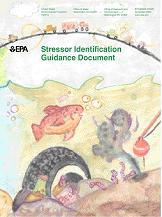Basic Information About CADDIS
What is CADDIS?
 CADDIS, or the Causal Analysis/Diagnosis Decision Information System, is an on-line application designed to help users conduct causal assessments, primarily in stream ecosystems
CADDIS, or the Causal Analysis/Diagnosis Decision Information System, is an on-line application designed to help users conduct causal assessments, primarily in stream ecosystems![]() ecosystemsWhere any portion of a natural community of plants, animals, and other living organisms and the physical environment in which they live and interact may be altered by climate change and it is in a plan or product it will be noted in the RAINE database.. It provides a logical, step-by-step framework for stressor identification
ecosystemsWhere any portion of a natural community of plants, animals, and other living organisms and the physical environment in which they live and interact may be altered by climate change and it is in a plan or product it will be noted in the RAINE database.. It provides a logical, step-by-step framework for stressor identification![]() stressor identificationA methodology for determining the most probable cause of an observed biological impairment, using elimination, diagnosis, and strength-of-evidence analysis. The CADDIS website is based on the Stressor Identification process, which is described in a U.S. EPA guidance document. based on the U.S. EPA’s Stressor Identification Guidance Document, as well as the CADDIS application provides additional information and tools that can be used in these assessments.
stressor identificationA methodology for determining the most probable cause of an observed biological impairment, using elimination, diagnosis, and strength-of-evidence analysis. The CADDIS website is based on the Stressor Identification process, which is described in a U.S. EPA guidance document. based on the U.S. EPA’s Stressor Identification Guidance Document, as well as the CADDIS application provides additional information and tools that can be used in these assessments.
Due to the scope and breath of the CADDIS application, it has been divided into 5 volumes to make it easier to locate information. These volumes are linked from the CADDIS home page and also linked to each volumes navigation for 1-click access.
These are:
- Volume 1. Stressor Identification
- Volume 2. Sources, Stressors and Responses
- Volume 3. Examples and Applications
- Volume 4. Data Anaylsis
- Volume 5. Causal Databases
Additional information about the using the CADDIS web site is included on frequent questions about CADDIS.
Why was CADDIS developed?
Thousands of water bodies in the United States are listed as biologically impaired. For many of these water bodies, the cause of impairment is reported as "unknown"—but before the TMDL![]() TMDLThe total allowable pollutant load to a receiving waterbody, such that any additional loading will produce a violation of water quality standards. process can be used to formulate appropriate management actions, the cause of biological impairment must be determined. Defensible causal analyses require knowledge of the mechanisms, symptoms, and stressor-response relationships for various stressors, as well as the ability to use that knowledge to draw appropriate conclusions. CADDIS was developed to provide users the information they need to conduct defensible causal assessments.
TMDLThe total allowable pollutant load to a receiving waterbody, such that any additional loading will produce a violation of water quality standards. process can be used to formulate appropriate management actions, the cause of biological impairment must be determined. Defensible causal analyses require knowledge of the mechanisms, symptoms, and stressor-response relationships for various stressors, as well as the ability to use that knowledge to draw appropriate conclusions. CADDIS was developed to provide users the information they need to conduct defensible causal assessments.
Who developed CADDIS?
CADDIS is produced by the U.S. EPA’s Causal Analysis Team in the Office of Research and Development's Center for Public Health and Environmental Assessment (CPHEA), formerly known as the National Center for Environmental Assessment (NCEA). Specific information for different sections of the site can be found on the Authors & Contributors page.
Why did we call this site CADDIS?
 Figure 1. Illustration of a Caddisfly LarvaeThe name CADDIS is an acronym for Causal Analysis/Diagnosis Decision Information System, but it also is the common name of an order of insects called caddisflies (Trichoptera). Caddisfly larvae (see Figure 1) live in flowing waters on the bottom surfaces of streams. Many species live in tubes or cases they construct from sand, pebbles, leaves, and wood, held together by an adhesive substance that the larvae secrete. They drag the case with them as they move, with only their front ends and legs sticking out. They eat algae, decaying plant matter and microorganisms, and are eaten by many types of fish.
Figure 1. Illustration of a Caddisfly LarvaeThe name CADDIS is an acronym for Causal Analysis/Diagnosis Decision Information System, but it also is the common name of an order of insects called caddisflies (Trichoptera). Caddisfly larvae (see Figure 1) live in flowing waters on the bottom surfaces of streams. Many species live in tubes or cases they construct from sand, pebbles, leaves, and wood, held together by an adhesive substance that the larvae secrete. They drag the case with them as they move, with only their front ends and legs sticking out. They eat algae, decaying plant matter and microorganisms, and are eaten by many types of fish.
Because many caddisfly species live only in high quality streams and decrease in abundance as stream quality declines, caddisflies are one type of organism that biologists often use to monitor the health of aquatic systems.
How to cite CADDIS?
U.S. EPA (Environmental Protection Agency). Causal Analysis/Diagnosis Decision Information System (CADDIS): Insert Web Page Title. Retrieved: Insert Month, Day, Year. Available from: Insert exact URL accessed or www.epa.gov/caddis for a general citation. Office of Research and Development, Washington, DC, 2017.
